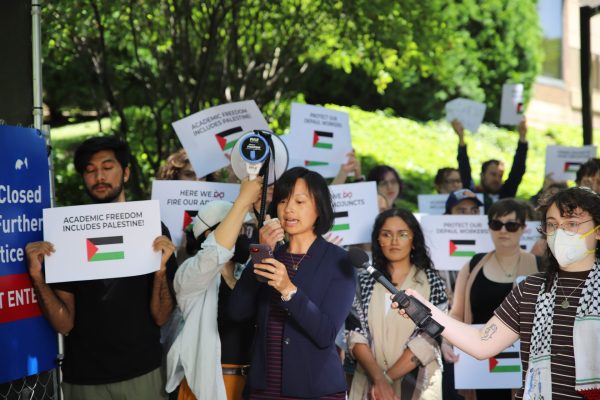Academic burnout brings into question student mental health, coping skills
As spring quarter comes to full bloom and students make their final push toward summer break, academic burnout threatens mental health and productivity, leading to symptoms like exhaustion, lack of motivation, and increased stress. When better weather and brighter days are not enough to ease these academic challenges, students look to healthy coping skills and solutions to prevent burning out before they can even tan in the sun.
Grace Lemmon, an associate professor in the Department of Management and entrepreneurship, defines academic burnout as when the demands of your life exceed your resources. Demands like time, emotion and attention help contribute to the likelihood of experiencing burnout. These can be manifested through indicators like workload balance, hours dedicated to classwork and social or emotional needs.
“As a student, you’re meant to be experiencing more than the facts and figures in your textbook,” Lemmon said. “Burnout comes not just when you feel overwhelmed with demands but also because you anticipate all of these stressors coming your way.”
Freshman Astrid Myers said they are currently experiencing a small amount of burnout but felt it is easier to manage as they adjust to life at DePaul. Their burnout is caused by a lack of rest after consistently working hard with little to no breaks or outside support.
“Last quarter, I worked so hard to get my grades up and to do well and I did that,” Myers said. “One week for spring break was not enough though. Jumping right back into class really hit me in the face, and now it’s hard to get energy from activities I usually enjoy.”
Lemmon believes students are at a higher risk of burnout due to their inexperience in dealing with the demands that lead to it. Not yet having the skills to manage the effects of burnout means students feel it more intensely and have not figured out their own solutions to remedy it.
“It’s a skill to be able to be aware that you’re burnt out and regulate around that burn out,” Lemmon said. “You don’t learn a lot in life about how to combat burnout. You hear people say to just take a rest or take some time off and you’ll be fine but it’s actually much more complicated than that. There are many additional steps you need to follow.”
Freshman Cailla Oakley-Lynch said she felt burnout while taking classes only related to her animation major. Many of these classes were project-based with conflicting deadlines which required more time spent at the Loop campus using software she does not have access to at home.
“If there’s a pretty good balance between having a lot of studying, labs, papers and creative assignments it makes a difference,” Oakley-Lynch said. “Being an animation major pushes burnout in a certain direction though because for me I physically cannot think of another thing to draw and I’m forgetting how to use the software because of how much work is piled up.”
Lemmon said falling into a “grindset” can worsen burnout by encouraging people to deny necessary moments of rest along with social and emotional connections. She said people can ignore these in favor of working on a side hustle for financial gain rather than a healthy mindset.
“I have this constant need to always be busy because if I’m not always doing something, then I’m not being productive,” Myers said. “With the mix of all these stressors in under one year, it’s really hard to feel like I’m doing well in my academics. I’m just tired all the time and I can feel it at the end of every quarter.”

According to Lemmon, there are two steps to overcome burnout: awareness and regulation. Awareness is recognizing the signs that indicate you are experiencing burnout such as feeling easily annoyed, having less energy to do fun activities you would normally say yes to, and generally lacking energy. Regulation is finding ways to make those signs more manageable through self care.
During winter quarter, Myers spent 20 hours over two days finishing a final project. Regulation for them means avoiding that same overworking pattern and instead focusing on taking breaks.
“Also, if I feel like I don’t have time to do things like hang out with friends, I try to combine it with doing something else,” Myers said. “Going to dinner together is always a good time where I feel like not only am I eating dinner but I’m also surrounding myself with other people.”
After awareness and regulation, Lemmon said experimentation to find the best solution is necessary since burnout can be from different demands or stressors each time and require different methods to alleviate it. This includes finding individualized restorative activities rather than mindlessly scrolling, prioritizing responsibilities to reevaluate stress, and accepting the fact you cannot do everything.
“It’s not possible to do it all,” Lemmon said. “You’re going to need to experiment with different things being a priority and not getting other stuff done. That is life and the earlier you can become comfortable with not being able to do it all, the better off you will be.”
Oakley-Lynch said she recognizes her burn out when experiencing low motivation, worsened procrastination and disorganization with her work.
“I really did not want to use my hand to draw, engineer or do anything that was even closely related to my major,” Oakley-Lynch said. “There’s a sort of misunderstanding between professors and students about workload, and it adds a lot of pressure that isn’t communicated early on.”
Although Lemmon does not believe burnout is completely preventable, she said the most important thing for students to understand is they can only do their best when it comes to recognizing and coping with burnout. She said acceptance of things makes burnout workable for students to manage and eventually solve.
“When you find yourself in a burnout state, know that you will not linger there long, you have tools and skills to hoist yourself out of that feeling, and you have the confidence to turn things around,” Lemmon said. “We can’t go through life avoiding discomfort and burnout is simply another discomfort.”
















